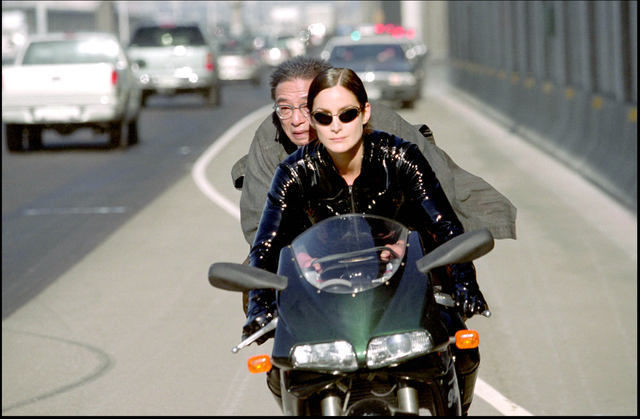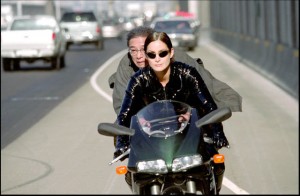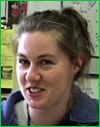
 Archival interview with Christine Renee Dye from the official Matrix website.
Archival interview with Christine Renee Dye from the official Matrix website.
MATRIX: What is your role in the Costume Department here in Alameda?
CHRISTINE: I’m sort of a floater in between handling the office things and being an assistant to Dan [Bronson, Costume Supervisor] and Elaine [Ramires, Key Costumer], I’m not really an assistant for Kym [Barrett, Costume Designer] because she has her own assistant, but I help out where I can. I also worked on the fittings, helping check some of the 950 extras in, and I worked in the dye shop, I actually got thrown in there with Niamh [Murphy, Key Dyer/Ager], so that was fun because I learnt a lot. So I’m sort of a jack of all trades on this show.
MATRIX: What is your history leading you to become a jack of all trades?
CHRISTINE: I have done community theatre since I was 12 years old, and by the time I was 14 I was running the Property Department for the community theatre I was in. A person came from San Francisco to Valeo who wanted to work with kids and teach them, he worked on a show called Midnight Caller that was filming here. He took a group of us and showed us what it was like to work on a show. I got to work in the scene shop on the weekends and learned how to build, and met people from all different areas of the show and learned what they did. He did seminars for us where we got to meet the UPM [Unit Production Manager], the casting people, and people who did what we wanted to do. He mentored some of us, and I ended up becoming good friends with him, so he mentored me. I didn’t really want to get into it, I liked theatre and that was what I wanted to do, I was training to be an opera singer – that was my background, I wanted to be an opera singer.
I ended up taking a job on a movie called Sphere as a Production Assistant to make more money so I could sing. From then I went to work in different departments, I’ve been in almost every department there is on shows. I met Barbara Hartman-Jenichen [Alterations] on Sphere, who is a good friend of mine now, and we did a couple of other shows together. She called me up one day and asked if I’d like to be a Costumer. I said, “Sure, which show are you on?” She was on The Bachelor, and I was on the same show but in production, so I said, “Sure, I’ll come over and make better money”. So that was my first time working in costume, she basically mentored me into it and I have ended up working on this show with her.
MATRIX: Have you continued singing since you fell into film?
CHRISTINE: Yes. The crew on Mumford actually raised money for me to go and audition in Toronto. It’s still back there, but it’s hard because of the hours we work to keep up with lessons. It’s something I love, for me it’s all the arts combined: it’s art direction, it’s costume, it’s scenery, it’s music, it’s everything. It’s certainly not film, but sometimes I think it has something that is lacking in film – the interaction – and you have the validation right there.
 MATRIX: How did things begin for you in the Alameda Costume Department for THE MATRIX sequels?
MATRIX: How did things begin for you in the Alameda Costume Department for THE MATRIX sequels?
CHRISTINE: In the beginning they started setting up the offices and I came in a week before the other Costumers to get things ready. Then I took over the cross checking because we were spending money left and right, and it was my job to enter everything and keep track of what we spent, then hand it off to Dan and the accountant. I did that in the very beginning, as well as answer the phones and that kind of thing, it’s a job that needs to be done. Then we started doing fittings and Niamh came up from Los Angeles, and everything got crazy because we started to get everything ready for the extras, so they threw me into the fittings. For half the day I would do fittings, checking people in, getting their measurements and setting everything up so they could go on to the next point where the next Costumer would take them and give them the clothing.
MATRIX: How many extras did you measure?
CHRISTINE: Our initial count was 740 people, then they added 200 more, at the end I think it was 941 and that count went up and down daily. The extras would come in, we’d dress them and send them to set, and the ADs would say, “We have to do more fittings, we want 200 more people”. So we’d do all those people, send them to set, then in between that we had to rush aging things. They did a scene where all these extras had to be dirty and look like they were in a fight. We lined them up out back and rushed out there and began dusting them and grease ragging them. We just went down the line and grabbed people telling them, you’re getting grease ragged, you’re getting this. I’d put people together with similar costumes, then bring one to Niamh and ask what we were going to do with this kind of costume, then I’d group them all together and we’d age them. Another day we were rushed out to set, and we had to age extras on set. I don’t remember how many people we did, maybe 100 people, everybody was out there doing a separate thing, dirtying them down.
MATRIX: How many of you were there doing the dirtying down?
CHRISTINE: There was Frank [Morales, Costumer], Niamh, Derek and me, there were four of us, then when we went to set it was basically everyone that was there. Everyone knows basically what to do, it was just that we were the ones working in the shop and the others were all on set that day, so we did it. It was everyone who could work the other day, even make up was out there putting blood on people in a big crowd just outside the set, it was crazy.
MATRIX: What was it like the first day all the extras came for the Zion Temple scene?
CHRISTINE: The days just blurred together last week, it was so long. The first day we did the extras we didn’t have the full count, we only had 300 or something, so we got here at 7am and it wasn’t as hugely monstrous as the days when we did 950 people. The first day we did the full 950 extras, we were here at 5am to dress everyone. We got to go home around 10.30 at night. All those days I know we got lunch, but I wasn’t even hungry because we were working so hard. One of my friends lost 10 pounds last week because of it, I lost maybe 5. Just the running around, we were constantly busy. I don’t remember ever sitting down or having a calm moment.
MATRIX: Did you take the measurements of every single extra who came into the Costume Department?
CHRISTINE: Yes, but not the main actors. On their measurement sheets there’d be every measurement, but for the extras, it was just shoe size, chest and, for women, hips. We had to get measurements on everyone so when we looked at them, we knew something when we’d go to pull a costume from the rack. I don’t know how to explain how much clothing was there at the beginning, it was really daunting, but at the end there was nothing, and that was daunting. A lot of times we’d ask for their weight, because we felt like that gave us a real clue to what they might be able to fit into. The fittings were interesting because we had to explain how translucent and see through the costumes were – basically stuff I would never wear – but thank God there were people that did. People didn’t really understand how see through the costumes were.
MATRIX: Did you have many people who didn’t want to wear the costume?
CHRISTINE: We had a couple of people who said they couldn’t do it. We did the initial fittings, and of course we had drop outs, so we would do more fittings everyday. They’d call people up, they’d come in, and we’d rush around deciding what we could put on these people. Some of these people would come in do the fitting, then say they couldn’t wear the costume at all.
MATRIX: Initially, did you try to accommodate people with costumes that had more coverage?
CHRISTINE: Yes, it was explained to everybody. We asked how comfortable they were with the sheerness of the fabric and said we’d do everything that we could to accommodate them to make them feel comfortable. If somebody didn’t want to wear a certain thing we would have them try something else. We bought these things called Nippets that somebody found on the internet, which are made by a doctor. They don’t cover the whole breast, they just cover the nipple, and that’s what we offered people who weren’t comfortable with the sheerness. From there they went to bandeaus and bras that matched the fabric of what they were wearing. We had to dye G strings a million different colors to match everybody’s flesh tones.
MATRIX: Were the G strings made by the Costume Department?
CHRISTINE: No, we purchased them. I had to go around and research which were the cheapest ones to buy because we were buying hundreds of pairs of them, and we just ordered them by catalogue and they came. At the end we were sending the driver out saying, “We’ve set these aside, can you pick these up for us?” We bought a lot of Nippets and a lot of underwear.
When we bought the Nippets, I went over to accounting after we got them because we were spending all this money and they had no idea what they were. So I went over to the accountants when we got them and gave them each a pair. I don’t think many people wore them because once everybody saw what everybody else was wearing they were comfortable.
MATRIX: What was the fitting process for the principal actors?
CHRISTINE: They have very special attention, of course. When they come Kym, Dan and Elaine usually fit them, and Mitzi [Haralson, Set Costumer] and Daniela [Moore, Set Costumer]were here for the stunt clones for the initial fitting. I couldn’t even tell you how many times the stunt clones were in here to get fitted and to make adjustments. They had harnesses that went under certain suits for some of the things they were doing, so they had different suits, some with the harness, some without, and they had to fit just right. I know that was a hard thing because they all had to look like Hugo.
All of them had to be the same height, so we had this big red line on our wall for the longest time where we had marked where Hugo’s head was. We’d line the stunt clones up with Hugo, or if he wasn’t there, just line them up and see if they were tall enough. We had to put lifts in their shoes to make everyone the same height – some people had a little more than others – sort of like Saturday Night Fever. There were different shoes too, I know they had shoes for static, when they were just standing, and then they had shoes for their stunts. I think there was one guy who was taller than Hugo, and that was not something you could fix. We take one picture of each of the extras and we take a whole roll of each of the principal actors.
MATRIX: The production is about to move to Australia, what preparations has the Costume Department made for that?
CHRISTINE: When we were doing the Neb sweaters, a lot of us kept notes of what we had done because we’re not doing all the multiples here, we don’t have time, so we just did one of each. We kept notes saying we’d used this much thread or this much yarn. We were cutting them up and darning them, so we’d keep that on the side and put it in a bag for all the mulitples so they would be the same. I took pictures of the Neb sweaters when I did them: I cut them up and unraveled them, then I’d put a piece of paper in between and take a Polaroid so you could see what it was like before I darned it up. I aged parts of the costumes: we had to rub them down with grease rags to age them, and I also did some of the pouches and belts and things like that.
MATRIX: Were the costumes begun in LA and then people moved here?
CHRISTINE: Yes, Niamh and Peggy [Schnitzer, Key Costumer] and a few other Costumers did the majority of the work, we just did what was needed here. They made it all and they dyed it all, although we did a lot of shoes.
MATRIX: What did you have to do with the shoes?
CHRISTINE: We grease ragged the sandals after they were painted, because painting took too long and grease ragging was much simpler. The first ones I did, Niamh had me do more detailed because they were the front background, and the way back ones we just touched with the grease rag.
MATRIX: How did you know who was going to be at the front and who was going to be at the back?
CHRISTINE: They had picked specific people. The first people we fit were called Diaphanous Revelers, those were the people who got to revel, ie: dance. They were all assigned a number and the first people that we fit were in the 100s, so those were the people they picked to be in the front. They had specific people like the Priestesses, the Councilors, the Ship Crew, the Warriors, the Band, who were all featured, then the rest of the people were just revelers, and they were the deep background.
MATRIX: Speaking of shoes, I have heard rumors of the ‘sandal story’?
CHRISTINE: We had to buy flip-flops for the extras to wear from the tent to the set because the pavement was really hot, and of course there were 950 pairs of them. When the extras got to set, the first extras thought – I’ll hide mine here, and I’ll hide mine here. There were some fire extinguishers lying there and some extras actually put theirs inside the hose. By the time everybody got on set there were piles and piles of sandals everywhere. It was like, how is anybody going to find anything, why didn’t we decide to wrangle them? So we grabbed boxes and markers and paper and safety pins, and went to the set and stuck together 950 pairs of sandals and put them in the boxes… wrangled them. It was so funny, our hands were so filthy, I had safety pin cuts all over my hands and I’ve never been able to get my thumb clean, it’s like a tattoo from putting the pins together and the dirt from the shoe. I think everybody who had to do that will remember that day. When we told the extras they had to pick up their shoes, a whole bunch of people couldn’t find their shoes, we had to get more shoes for them. We said, “Keep these shoes, put your number on them, and when you come back for the next shot, put your shoes back”. Well they didn’t, they put them all over the ground again.
MATRIX: Thanks Christine.
Interview by REDPILL
June 2001

Be the first to comment